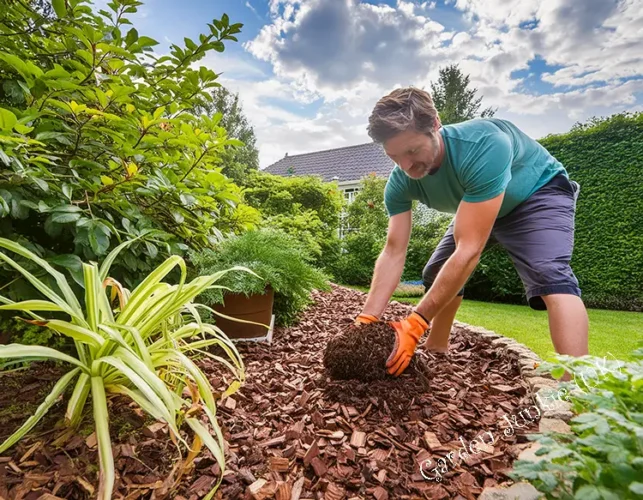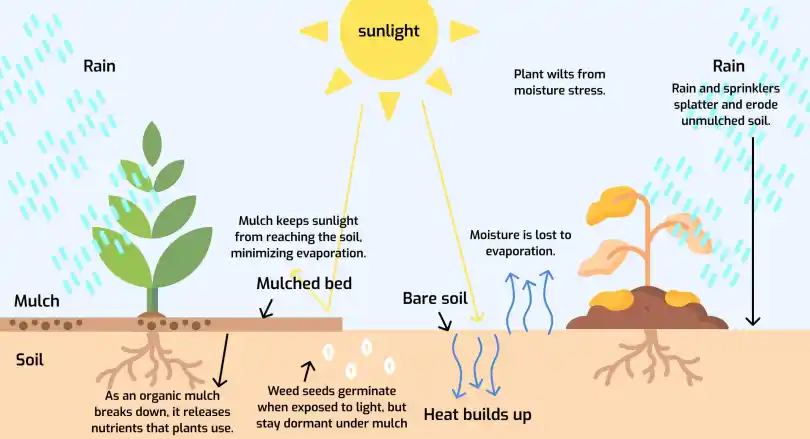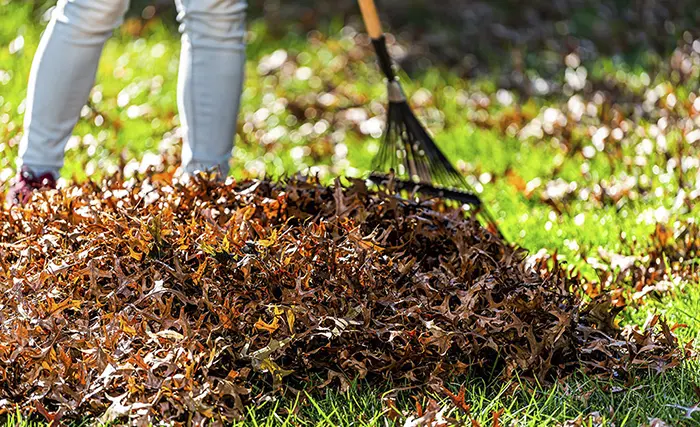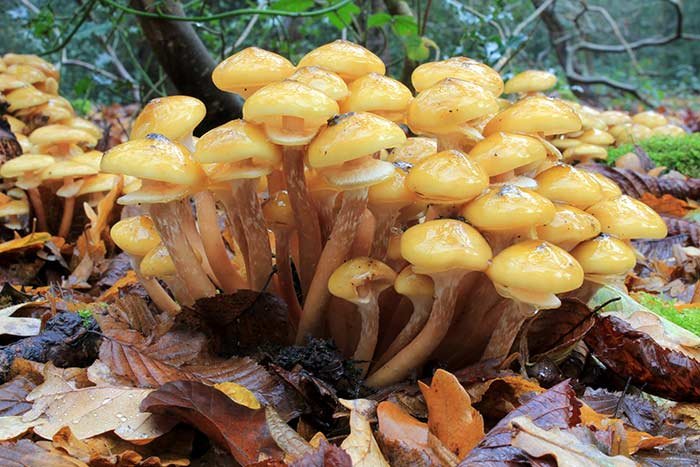Beautiful Plants For Your Interior
Mulching: Benefits, Techniques, and Materials

What is mulching? Mulching is a gardening technique that involves ‘spreading’ a layer of material over the soil around plants. The material used for mulching can be organic or inorganic, and it serves several purposes, such as conserving soil moisture, suppressing weed growth, and regulating soil temperature. Mulching is an essential practice for gardeners looking to improve the health and productivity of their plants.

Mulching: A Great Practice to Improve Your Garden’s Overall Health
Key Takeaways
- Importance of Mulching
- Types of Mulch
- Mulching Techniques
- Benefits and Problems with Mulching
One of the primary benefits of mulching is that it helps to retain soil moisture. By covering the soil with a layer of mulch, water is prevented from evaporating too quickly, which can be especially helpful during hot and dry periods. Additionally, mulching can help to suppress the growth of weeds, which can and often do compete with plants for water and nutrients. Mulch also helps to maintain a consistent soil temperature, which can be beneficial for plants that are sensitive to extreme temperature fluctuations.
If you’re new to mulching, it can be challenging to know where to start. Fortunately, there are many resources available that can help you learn more about this essential gardening technique. We will go through all the essential knowledge you will need to get going below.

Garden Mulching: There are many benefits to mulching including ‘moisture’ retention within the soil.
Mulching is an essential gardening technique that provides numerous benefits to plants, soil, and the overall landscape. Here are some of the key reasons why mulching is important:
Soil Health and Fertility
Mulching helps improve soil health and fertility by adding ‘organic’ matter to the soil. Organic matter is essential for maintaining good soil structure and water retention capacity. Mulch also helps to control soil erosion, which can lead to nutrient depletion and soil compaction.
Moisture Retention and Weed Suppression
Mulching helps retain soil moisture by reducing the rate of evaporation. This is especially important during hot and dry weather conditions. By reducing the amount of water lost to evaporation, plants have more access to water, which is essential for growth and development. Mulching also helps to suppress weed growth by blocking out sunlight, which is necessary for weed germination.
Protection Against Extreme Weather
Mulching protects against extreme weather conditions such as heavy rain and frost. During heavy rain, mulch helps to prevent soil erosion and nutrient leaching. During frost, mulch acts as an insulating layer, which helps to protect plant roots from freezing temperatures.
In summary, mulching is an essential gardening technique that provides numerous benefits to plants, soil, and overall landscape. By improving soil health and fertility, retaining soil moisture, suppressing weed growth, and providing protection against extreme weather, mulching helps to promote healthy and thriving gardens.
Mulching: Mulching 101 for Beginners. Why You Mulch
Types of Mulch
As we have seen, mulch is a layer of material applied on top of the soil to help retain moisture, suppress weed growth and regulate soil temperature. There are two main types of mulch: organic and inorganic.
Organic Mulches
Organic mulches are made from natural materials that decompose over time, adding nutrients to the soil. Some common organic mulches include bark, straw, and leaves. Bark mulch is a popular choice for gardeners as it is long-lasting and helps to regulate soil temperature.
Straw is another popular option, particularly for vegetable gardens, as it is easy to apply and breaks down quickly, adding organic matter to the soil. Leaves are also an excellent choice for mulch as they are readily available, and when shredded, they break down quickly, adding nutrients to the soil.
Inorganic Mulches
Inorganic mulches are made from non-living materials such as gravel, pebbles, rocks, and rubber.
These mulches do not decompose and, as such, do not add nutrients to the soil. However, they are long-lasting and can be an effective way to suppress weed growth and regulate soil temperature. Gravel and pebbles are popular choices for pathways and around potted plants, while rubber mulch is commonly used in playgrounds and other high-traffic areas.
Therefore, when choosing mulch, it is important to consider whether you want or need biodegradable (organic) or non-biodegradable (inorganic). Biodegradable mulches, such as bark, straw, and leaves, break down over time, adding nutrients to the soil. Non-biodegradable mulches, such as gravel and rubber, do not break down and can be reused year after year.
In summary, there are many types of mulch available, both organic and inorganic. Gardeners should choose a mulch based on their specific needs, taking into consideration factors such as the type of plants being grown, the climate, and the desired aesthetic.
Choosing the Right Mulch
Mulching is an essential part of gardening as we have discovered and choosing the right mulch can make all the difference. Mulch helps to retain moisture, suppress weeds, regulate soil temperature, and improve soil structure. There are many different types of mulch available, and each has its own benefits and drawbacks so let’s explore the options in more detail.
For Flower Beds and Borders
When choosing mulch for flower beds and borders, it’s important to consider the aesthetic qualities of the mulch. Organic mulches such as bark chips, wood shavings, and straw are popular choices as they ‘decompose’ slowly and add nutrients to the soil. Pebbles and stones are also popular choices, especially in Mediterranean-style gardens.
For Vegetable Gardens
In vegetable gardens, it’s important to choose a mulch that will add nutrients to the soil and suppress weeds. Organic mulches such as straw, grass clippings, and compost are excellent choices as they decompose quickly and add nutrients to the soil. Black plastic or a woven black membrane mulch are also popular choices as they warm the soil and suppress weeds.
For Trees and Shrubs
When mulching around trees and shrubs, it’s important to choose a mulch that won’t smother the plants. Organic mulches such as bark chips, wood shavings, and straw are excellent choices as they allow air and water to penetrate the soil. It’s important to avoid mulching too close to the trunk of the tree or shrub, as this can cause the bark to rot.
When choosing mulch, it’s important to consider the needs of the plants, the climate, and the aesthetic qualities of the mulch. By choosing the right mulch, gardeners can improve the health and appearance of their plants while reducing the amount of time and effort required to maintain them.
Mulching Techniques
Mulching is a simple and effective way to improve the health of your garden. There are a variety of techniques to choose from, each with its own benefits. In this part of our post, we will explore two popular mulching techniques: Layering and Spreading, and Timing and Seasonal Considerations.
Layering and Spreading
There are two main ways to apply mulch: Layering and Spreading. Layering involves placing a ‘thick’ 4-6in (100-150mm) layer of mulch on top of the soil while ‘spreading’ involves evenly distributing a thinner layer 1-2in (25-50mm) of ‘mulch’ across the soil surface. Both methods have their benefits and drawbacks.
Layering is more effective at suppressing weeds and retaining moisture but can be more difficult to apply evenly. Spreading is easier to apply and may look good, but it ‘compresses’ easily and may not provide as much weed suppression or moisture retention.
If you put too much mulch down, it can cause other issues. Too thick a mulch may stop water from getting to the soil and suffocate your plants.
The ideal thickness for mulch is 2-4in (50-100mm). Keeping your mulch at this depth will improve the health of your plants and soil, and reduce the amount of water you need to add.
In addition to the thickness, when applying mulch, it is not only important to spread it evenly but also try to avoid piling mulch up against ‘woody’ plant stems. This can cause the stems to rot and attract pests and diseases.

Mulching: Collecting Fallen Leaves and Shredding Them is a Cheap And Easy Way to Get Organic Mulch
Timing and Seasonal Considerations
The timing of mulching is important for maximising its benefits. In general, it is best to mulch in the Spring or early Winter, before the ground freezes. This allows the mulch to settle in and begin to decompose before the growing season begins.
Mulching in the Autumn can also be effective, but care should be taken to avoid mulching too early in the season. This can trap moisture and promote fungal growth, which can be harmful to plants.
When mulching in the winter, it is important to wait until after the first frost. This ensures that the ground has cooled sufficiently and reduces the risk of damaging tender plants.
Overall, mulching is a simple and effective way to improve the health of your garden. By spreading or layering mulch at the right time, you can suppress weeds, retain moisture, and promote healthy plant growth.
Benefits of Organic Mulches
Organic mulches offer many benefits to gardeners. They are made from natural materials such as compost, manure, leaf mould, and well-rotted manure. Here are some of the benefits of using organic mulches in your garden:
Improving Soil Fertility
One of the main benefits of using organic mulches is that they can improve soil fertility. Organic mulches are rich in nutrients such as nitrogen, which is essential for plant growth. As the mulch breaks down, it releases these nutrients into the soil, providing a long-lasting source of food for plants. Organic mulch also helps to improve soil structure and fertility over time.
Encouraging Beneficial Organisms
Organic mulches can also help to encourage beneficial organisms in the soil. For example, saprophytic fungi, which break down dead organic matter, thrive in moist, organic-rich soil. These fungi help to decompose the mulch and release nutrients into the soil. They also help to improve soil structure by creating channels for ‘air and water’ to move through.
In addition to these benefits, organic mulches can also help to:
- Conserve soil moisture by reducing evaporation
- Suppress weed growth by blocking light to weed seeds
- Prevent soil erosion by protecting the soil surface from rain and wind
- Insulate plant roots from extreme temperatures
Some popular types of organic mulches include garden compost, mushroom compost, farmyard manure, and homemade compost. When choosing an organic mulch, it’s important to consider the needs of your plants and the characteristics of your soil. For example, if your soil is already high in nitrogen, you may want to choose a mulch that is lower in nitrogen to avoid over-fertilising your plants.
Overall though, organic mulches are a valuable tool for gardeners who want to improve soil fertility, encourage beneficial organisms, and promote healthy plants.
Issues with Mulching
Mulching has many benefits for gardeners, but there are also some issues to consider. In this part of the post, we will look at two main concerns: pest and disease risks, and over-mulching.
Pest and Disease Risks
Mulching can create a warm and moist environment that is ideal for pests and diseases. For example, slugs can thrive under a layer of mulch, and weed seeds can germinate and grow in nutrient-rich soil. To reduce these risks, it is important to use high-quality mulch that is free from pests and diseases. Gardeners should also avoid using too much mulch, as this can create a habitat for pests and diseases to thrive.
Over-Mulching Concerns
Over-mulching can cause several problems for gardeners. Firstly, it can prevent water from reaching the soil, leading to waterlogging and root rot. Secondly, it can prevent air from reaching the soil, leading to a lack of oxygen and poor plant growth. Finally, over-mulching can create a habitat for honey fungus, a fungus that can kill trees and shrubs.
To avoid these issues, gardeners should try and only use mulch layers (layering) as described previously in this post
In summary, while mulching has many benefits for gardeners, it is important to be aware of the potential pitfalls. By using high-quality mulch, avoiding over-mulching, and being vigilant for pests and diseases, gardeners can enjoy the benefits of mulching while minimising the risks.

Mulching: Over Mulching Can Create an Environment For Honey Fungus (Armillaria mellea)
Environmental Considerations
Mulching is not only an effective way of improving soil health and plant growth, but it also has several environmental benefits. In this part of the post, we will look at some of the most important environmental considerations when it comes to mulching.
Sustainable Mulching Practices
One of the most significant environmental benefits of mulching is that it can be done sustainably. Mulching with organic materials like leaves, grass clippings, and wood chips is an excellent way of ‘recycling’ garden waste, by reducing the amount of waste that ends up in landfills. This reduces greenhouse gas emissions and helps to combat climate change.
Another sustainable mulching practice is the use of landscape fabric or permeable sheeting. These materials allow water to pass through while still suppressing weeds and retaining moisture in the soil. Using ‘plastic’ sheeting used by many as a ‘mulch’ barrier is not whole heartedly recommended by many gardeners as it does not allow water to pass through and can lead to waterlogging.
The Royal Horticultural Society and gardeners’ charities recommend using sustainable mulching practices to create a beautiful, healthy garden while reducing your impact on the environment.
Recycling Garden Waste
Mulching with garden waste is an excellent way of recycling organic material and reducing the amount of waste that ends up in landfills. By using garden waste, you can save money on fertilisers and reduce your carbon footprint.
When mulching with garden waste, it is important to use only disease-free materials. Avoid using any plants that have been treated with herbicides or pesticides, as these chemicals can harm beneficial insects and soil microorganisms.
Mulching with garden waste is an easy way to create a beautiful, healthy garden while reducing your impact on the environment. It is a win-win situation for both your garden and the planet.
Mulching and Wildlife
Mulching not only benefits plants but can also attract beneficial wildlife to your garden. Here are some considerations to keep in mind when mulching to promote biodiversity and attract wildlife to your garden.
Attracting Beneficial Wildlife
Mulching with organic materials provides a habitat for insects and other small animals, which in turn can attract birds and other wildlife. For example, a layer of ‘leaf litter’ can provide shelter for ground-dwelling insects, which can attract birds that feed on them.
Mulching can also help to support soil-dwelling organisms, such as earthworms, which are important for maintaining soil health and fertility. By providing a steady supply of organic matter, mulch can also help to create a healthy soil ecosystem that supports a wide range of beneficial organisms.
Safety Considerations for Pets
While mulching can be beneficial for wildlife, it is important to consider the safety of pets, particularly dogs, when choosing a mulch. Some types of mulch, such as cocoa bean mulch, can be toxic to dogs if ingested.
To ensure the safety of your pets (if you have them), it is recommended to use organic mulches that are ‘free’ from harmful chemicals and to avoid using mulches that may be attractive to pets, such as those made from food waste or other organic materials that may have a strong odour.
In summary, mulching can provide a range of benefits for both plants and wildlife. By choosing the right type of mulch and considering the needs of pets, gardeners can create a healthy and biodiverse ecosystem that supports a wide range of beneficial organisms.
FAQ’s
How often should I replenish mulch in my garden?
Mulch should be replenished once a year, typically in the spring. This helps maintain the desired thickness and ensures that the mulch continues to provide it’s benefits to the soil and plants.
Is it necessary to remove old mulch before applying a new layer?
It’s generally not necessary to remove old mulch before applying a new layer. Over time, the old mulch will break down and contribute to the organic matter in the soil. However, if the old mulch is excessively matted or harbouring diseases, it may be beneficial to remove it.
Can I use grass clippings as mulch in my garden?
Yes, grass clippings can be used as mulch in the garden. However, it’s important to use them in thin layers to prevent matting and allow air and water to reach the soil.
Conclusion
In conclusion, mulching is a beneficial practice for maintaining healthy soil and promoting plant growth. It helps to retain moisture, control weeds, regulate soil temperature, and add organic matter to the soil.
There are various types of mulch to choose from, and each has its own advantages and disadvantages. By selecting the right mulch for your garden or landscape, you can improve the overall health and appearance of your plants while reducing the need for water and maintenance.
Overall, mulching is an effective and sustainable way to support the health of your garden and the environment.
